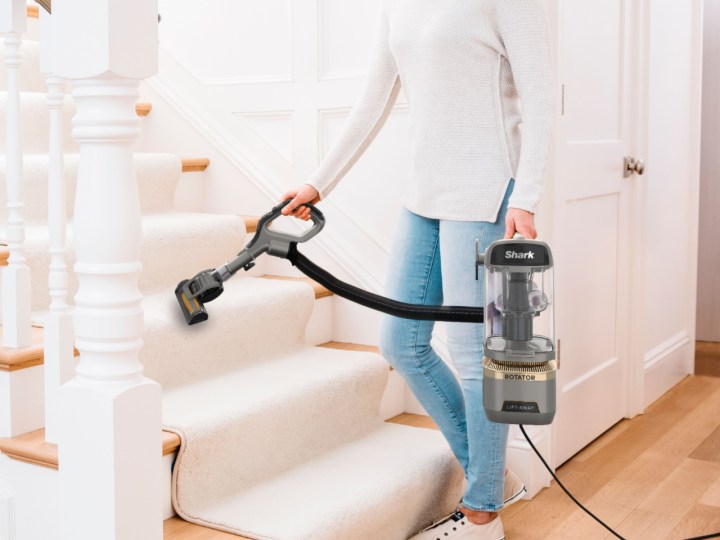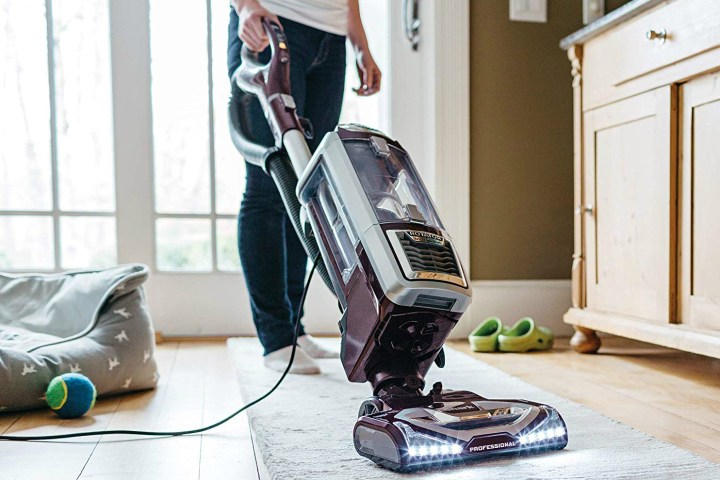Shark is a powerful name in the world of vacuum technology. Producing an expansive lineup of products, from traditional upright and cordless models to some of the best robot vacuums on the market, there’s a Shark vac for every home, budget, want, need, and specialized cleaning task. While many of these Shark vacuums are designed to last for years, this doesn’t mean you won’t run into trouble occasionally. Common troubles can include things like loss of power, decreased mobility, as well as networking issues.
Not to worry though: We’ve put together this exhaustive guide that identifies a number of key issues found across both traditional and robotic Shark vacuums, with troubleshooting tips and solutions provided for each fault.
Power failure

If your Shark vacuum isn’t turning on, there could be several reasons why. For starters, if you’re using a traditional corded model, you’ll want to verify the AC outlet you’re plugging into is working properly. Sometimes, the amperage draw of an older or more powerful vacuum can cause a short in the circuit that the outlet uses.
To troubleshoot, you can try plugging another device into the outlet to see if it powers on, or use an outlet tester if you have one handy. If the outlet is dead, head to the main electrical panel in your home to see if the breaker has been tripped. A fault in the motor or wiring can also lead to zero power, especially for traditional models. If you’re not up for DIY repairs, we’d suggest taking the vac to be serviced professionally.
For Shark robot vacuums, no power could simply mean that the battery may not be charged. If the vacuum doesn’t seem to be charging at all, there could be an issue with the charging contacts on the Shark’s docking station. If the onboard battery is completely dead, you can typically order a replacement unit for most Shark robot vacuums.
Loss of suction and overheating

When your Shark vacuum begins to lose suction power and overheat, there’s a handy temperature-protection sensor that will kick into gear, automatically cutting off power to the vacuum until it’s cool enough to begin cleaning again.
While it’s normal for a Shark vacuum to overheat once in a while — especially if you’ve been vacuuming for a particularly long time — repeated overheating can point toward a larger issue that should be addressed before the vacuum’s motor shorts out.
In the case of suction loss, you may notice that your Shark vacuum isn’t picking up debris the way it normally does, or that you have to hit the same area multiple times for the vacuum to collect everything. Read our guide on how to fix a Shark vacuum that’s not sucking for more tips.
If left untreated, both a loss of suction power and overheating can result in a vacuum shutdown, but other symptoms can include louder and higher-pitched motor sounds. Unaddressed, an inefficient vacuum can often result in motor failure.
Here are a few possible causes for both loss of suction and overheating, as well as some solutions.
Restricted airflow
One culprit of excessive overheating is restricted airflow. If you’re using a traditional Shark vacuum, check to make sure there are no significant blockages in any hoses or attachments. Even a seemingly small clump of hair could cause enough of a jam to make it harder for your Shark vacuum to work efficiently, which can result in the unit overheating. Before vacuuming, make sure to check all hoses and attachments for blockages and remove them if you see any.
An onboard HEPA filter can also be causing restricted airflow. Designed to power through multiple cleaning cycles, filters eventually need to be cleaned or replaced. Depending on which Shark vacuum you own, the main filter (in most cases) will be located either behind the filter cover on the lower end of traditional models or inside the dirt tank on robotic models.
Ideally, replaceable filters should be swapped every one to two months.
The brushroll is filled with hair
A hair-laden roller brush can also cause your Shark vacuum to overheat. Think of those human and pet hairs as giant lassoes that are holding the roller back from spinning the way it should. The hair usually means the roller is going to have to work harder to spin, which can cause the Shark vac to start running hot.
If you can see that your roller brush is bogged down with hair, remove the roller from the vacuum chassis, physically pull the hairs off the brush and its assembly, then re-attach.
The dirt tank is too full
On both traditional and robotic Shark vacuums, dirt and debris are sucked up and transferred to the vacuum’s onboard dirt tank. If you don’t keep up with emptying the detritus after every few cleanings, the vacuum can start to work less efficiently, which can mean overheating.
If you can see that the dirt tank is filled to the brim, open it up, empty it, wait for the vac to cool down, and try vacuuming again.
Signs of motor failure

Overheating and loud operating sounds could also mean your Shark vacuum is ready to kick the can, especially if you’ve owned it for a long time. Additionally, both symptoms could point to some kind of tear or fray in the wiring of traditional models.
Exposed wiring is a major hazard, so you’ll want to ensure the vacuum is unplugged before troubleshooting. If you notice any tears in the electrical cord, there are a number of guides you can follow to repair the wiring if you’re of the DIY mindset. If you’re any bit apprehensive about approaching the repair yourself though, we recommend you take it to a vacuum repair shop.
Limited mobility

Have you noticed that your Shark upright is harder to push across the carpeting of late? Or is your Shark robot vacuum not sweeping the floors the way it usually does. One culprit could be clogged-up wheels and brushes.
Both traditional and robot Shark vacs have adjustable wheels that raise and lower depending on the floor setting (for traditional models — most robotic units handle this function automatically). With the vacuum unplugged, flip it upside down to see if the main wheels are filled with hair.
Most wheels can be removed, allowing you to pick the excess hair off the axles and housings. It’s also a good idea to check the brushroll, too, as a buildup of hair on this vital component can cause limited mobility, too. Once removed, reattach to see if you’ve gained mobility back.
Why does my Shark vacuum keep stopping?
For Shark robotic models, odd sweeping or sudden stops can often be a result of dirty vacuum sensors. These sensors can often be found on the bottom and sides of the vacuum. Hitting them with a soft cloth should be enough to remove any excess dirt. Once cleaned, power up the robot vac and send it for a test run to see if it’s working normally again.
Wi-Fi issues
Shark’s extensive lineup of robot vacuums can be connected to Wi-Fi, allowing you to control and customize the vacuum’s cleaning capabilities through a companion app on your phone. After connecting to your network, many models will also use an onboard mapping system to draw blueprints of the rooms in your home. These maps are then stored in the app, allowing you to tell the vacuum which rooms to clean (including when and for how long), as well as what locations to stay away from.
In order for your Shark robot vac to effectively use its built-in navigation tools and mapping functions, most models require a constant, solid Wi-Fi connection. In the event that your vac loses its connection to the network, there are a few fixes you can try.
If your vacuum isn’t connecting to Wi-Fi at all, make sure that you’re inputting the correct network name and password during setup. Passwords are usually case-sensitive, so even one lowercase letter that should be capitalized could be the culprit. If at any point you decide to change your network name and password, you’ll also have to change these login essentials in your Shark’s companion app.
Additionally, many Shark robot vacs can only be paired to a 2.4GHz network. So, if you’ve been trying to jump on a 5GHz band, your vacuum simply may not be compatible.
There could be an issue with the range of your Wi-Fi router, at least in its effectiveness to send Wi-Fi to your mobilized Shark vacuum. If your router is located inside a media cabinet or stowed on the bottom shelf of your entertainment center, relocate the unit to an open-air environment, where the broadcast antennas will do their best work.
If all else fails, you can always try unplugging your router, waiting about 10 seconds, then reconnecting it. Sometimes all you need is a tried-and-true hard reset to fix any Wi-Fi issues across a range of different devices, not just web-connected Shark vacuums.



